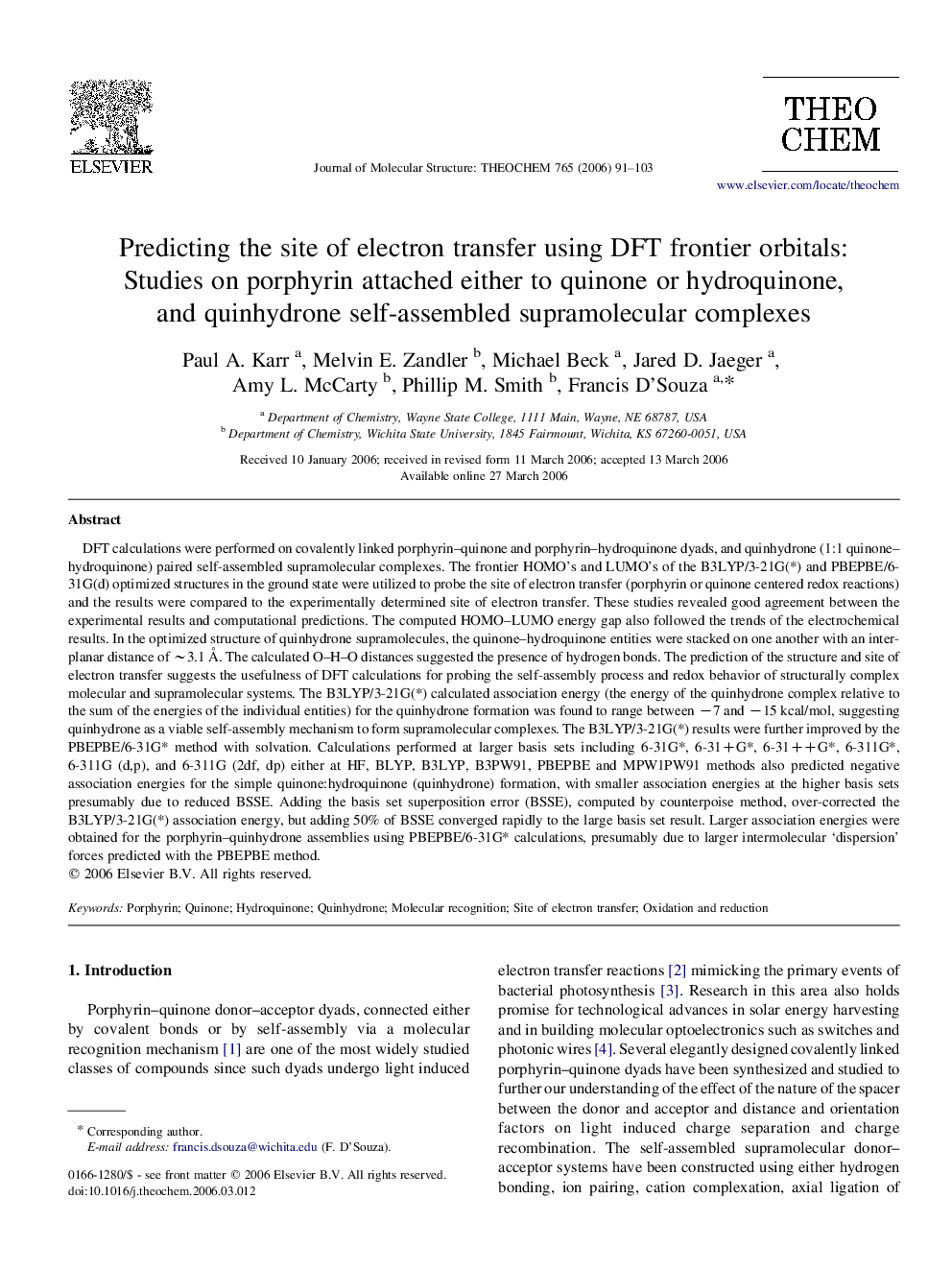| کد مقاله | کد نشریه | سال انتشار | مقاله انگلیسی | نسخه تمام متن |
|---|---|---|---|---|
| 5418579 | 1506992 | 2006 | 13 صفحه PDF | دانلود رایگان |
عنوان انگلیسی مقاله ISI
Predicting the site of electron transfer using DFT frontier orbitals: Studies on porphyrin attached either to quinone or hydroquinone, and quinhydrone self-assembled supramolecular complexes
دانلود مقاله + سفارش ترجمه
دانلود مقاله ISI انگلیسی
رایگان برای ایرانیان
کلمات کلیدی
موضوعات مرتبط
مهندسی و علوم پایه
شیمی
شیمی تئوریک و عملی
پیش نمایش صفحه اول مقاله

چکیده انگلیسی
DFT calculations were performed on covalently linked porphyrin-quinone and porphyrin-hydroquinone dyads, and quinhydrone (1:1 quinone-hydroquinone) paired self-assembled supramolecular complexes. The frontier HOMO's and LUMO's of the B3LYP/3-21G(*) and PBEPBE/6-31G(d) optimized structures in the ground state were utilized to probe the site of electron transfer (porphyrin or quinone centered redox reactions) and the results were compared to the experimentally determined site of electron transfer. These studies revealed good agreement between the experimental results and computational predictions. The computed HOMO-LUMO energy gap also followed the trends of the electrochemical results. In the optimized structure of quinhydrone supramolecules, the quinone-hydroquinone entities were stacked on one another with an inter-planar distance of â¼3.1Â Ã
. The calculated O-H-O distances suggested the presence of hydrogen bonds. The prediction of the structure and site of electron transfer suggests the usefulness of DFT calculations for probing the self-assembly process and redox behavior of structurally complex molecular and supramolecular systems. The B3LYP/3-21G(*) calculated association energy (the energy of the quinhydrone complex relative to the sum of the energies of the individual entities) for the quinhydrone formation was found to range between â7 and â15Â kcal/mol, suggesting quinhydrone as a viable self-assembly mechanism to form supramolecular complexes. The B3LYP/3-21G(*) results were further improved by the PBEPBE/6-31G* method with solvation. Calculations performed at larger basis sets including 6-31G*, 6-31+G*, 6-31++G*, 6-311G*, 6-311G (d,p), and 6-311G (2df, dp) either at HF, BLYP, B3LYP, B3PW91, PBEPBE and MPW1PW91 methods also predicted negative association energies for the simple quinone:hydroquinone (quinhydrone) formation, with smaller association energies at the higher basis sets presumably due to reduced BSSE. Adding the basis set superposition error (BSSE), computed by counterpoise method, over-corrected the B3LYP/3-21G(*) association energy, but adding 50% of BSSE converged rapidly to the large basis set result. Larger association energies were obtained for the porphyrin-quinhydrone assemblies using PBEPBE/6-31G* calculations, presumably due to larger intermolecular 'dispersion' forces predicted with the PBEPBE method.
ناشر
Database: Elsevier - ScienceDirect (ساینس دایرکت)
Journal: Journal of Molecular Structure: THEOCHEM - Volume 765, Issues 1â3, 15 June 2006, Pages 91-103
Journal: Journal of Molecular Structure: THEOCHEM - Volume 765, Issues 1â3, 15 June 2006, Pages 91-103
نویسندگان
Paul A. Karr, Melvin E. Zandler, Michael Beck, Jared D. Jaeger, Amy L. McCarty, Phillip M. Smith, Francis D'Souza,